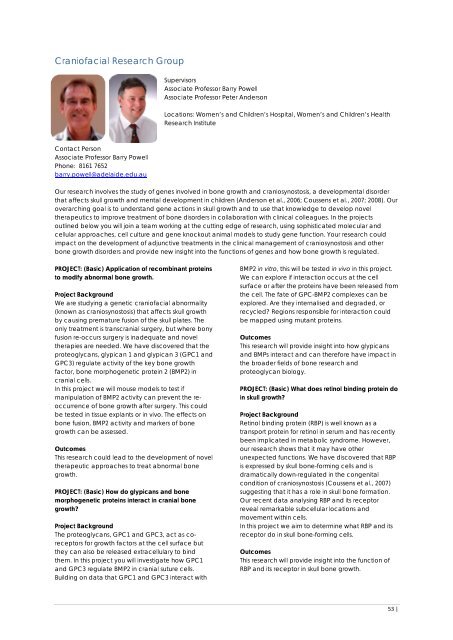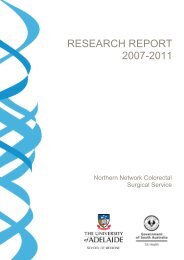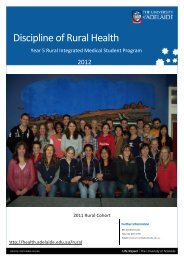Honours Project Book - Faculty of Health Sciences - University of ...
Honours Project Book - Faculty of Health Sciences - University of ...
Honours Project Book - Faculty of Health Sciences - University of ...
You also want an ePaper? Increase the reach of your titles
YUMPU automatically turns print PDFs into web optimized ePapers that Google loves.
Crani<strong>of</strong>acial Research Group<br />
Contact Person<br />
Associate Pr<strong>of</strong>essor Barry Powell<br />
Phone: 8161 7652<br />
barry.powell@adelaide.edu.au<br />
Supervisors<br />
Associate Pr<strong>of</strong>essor Barry Powell<br />
Associate Pr<strong>of</strong>essor Peter Anderson<br />
Locations: Women’s and Children’s Hospital, Women’s and Children’s <strong>Health</strong><br />
Research Institute<br />
Our research involves the study <strong>of</strong> genes involved in bone growth and craniosynostosis, a developmental disorder<br />
that affects skull growth and mental development in children (Anderson et al., 2006; Coussens et al., 2007; 2008). Our<br />
overarching goal is to understand gene actions in skull growth and to use that knowledge to develop novel<br />
therapeutics to improve treatment <strong>of</strong> bone disorders in collaboration with clinical colleagues. In the projects<br />
outlined below you will join a team working at the cutting edge <strong>of</strong> research, using sophisticated molecular and<br />
cellular approaches, cell culture and gene knockout animal models to study gene function. Your research could<br />
impact on the development <strong>of</strong> adjunctive treatments in the clinical management <strong>of</strong> craniosynostosis and other<br />
bone growth disorders and provide new insight into the functions <strong>of</strong> genes and how bone growth is regulated.<br />
PROJECT: (Basic) Application <strong>of</strong> recombinant proteins<br />
to modify abnormal bone growth.<br />
<strong>Project</strong> Background<br />
We are studying a genetic crani<strong>of</strong>acial abnormality<br />
(known as craniosynostosis) that affects skull growth<br />
by causing premature fusion <strong>of</strong> the skull plates. The<br />
only treatment is transcranial surgery, but where bony<br />
fusion re-occurs surgery is inadequate and novel<br />
therapies are needed. We have discovered that the<br />
proteoglycans, glypican 1 and glypican 3 (GPC1 and<br />
GPC3) regulate activity <strong>of</strong> the key bone growth<br />
factor, bone morphogenetic protein 2 (BMP2) in<br />
cranial cells.<br />
In this project we will mouse models to test if<br />
manipulation <strong>of</strong> BMP2 activity can prevent the reoccurrence<br />
<strong>of</strong> bone growth after surgery. This could<br />
be tested in tissue explants or in vivo. The effects on<br />
bone fusion, BMP2 activity and markers <strong>of</strong> bone<br />
growth can be assessed.<br />
Outcomes<br />
This research could lead to the development <strong>of</strong> novel<br />
therapeutic approaches to treat abnormal bone<br />
growth.<br />
PROJECT: (Basic) How do glypicans and bone<br />
morphogenetic proteins interact in cranial bone<br />
growth?<br />
<strong>Project</strong> Background<br />
The proteoglycans, GPC1 and GPC3, act as coreceptors<br />
for growth factors at the cell surface but<br />
they can also be released extracellulary to bind<br />
them. In this project you will investigate how GPC1<br />
and GPC3 regulate BMP2 in cranial suture cells.<br />
Building on data that GPC1 and GPC3 interact with<br />
BMP2 in vitro, this will be tested in vivo in this project.<br />
We can explore if interaction occurs at the cell<br />
surface or after the proteins have been released from<br />
the cell. The fate <strong>of</strong> GPC-BMP2 complexes can be<br />
explored. Are they internalised and degraded, or<br />
recycled? Regions responsible for interaction could<br />
be mapped using mutant proteins.<br />
Outcomes<br />
This research will provide insight into how glypicans<br />
and BMPs interact and can therefore have impact in<br />
the broader fields <strong>of</strong> bone research and<br />
proteoglycan biology.<br />
PROJECT: (Basic) What does retinol binding protein do<br />
in skull growth?<br />
<strong>Project</strong> Background<br />
Retinol binding protein (RBP) is well known as a<br />
transport protein for retinol in serum and has recently<br />
been implicated in metabolic syndrome. However,<br />
our research shows that it may have other<br />
unexpected functions. We have discovered that RBP<br />
is expressed by skull bone-forming cells and is<br />
dramatically down-regulated in the congenital<br />
condition <strong>of</strong> craniosynostosis (Coussens et al., 2007)<br />
suggesting that it has a role in skull bone formation.<br />
Our recent data analysing RBP and its receptor<br />
reveal remarkable subcellular locations and<br />
movement within cells.<br />
In this project we aim to determine what RBP and its<br />
receptor do in skull bone-forming cells.<br />
Outcomes<br />
This research will provide insight into the function <strong>of</strong><br />
RBP and its receptor in skull bone growth.<br />
53 |





